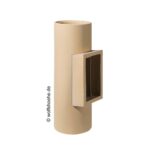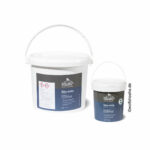Home | Chimney pipes
Ceramic chimney pipes for chimney systems
… reliable & high quality
In our range of ceramic fireclay flue pipes, you will find components for the entire flue gas system: alongside standard pipes, we also offer solutions for cleanout openings, for connections to smoke pipes and cleanout openings, for LAS systems and for the chimney base. We offer our products in various diameters for the suitable chimney dimensions.
Properties
Our ceramic pipes offer the greatest possible flexibility as well as optimum quality and service life:
- high mechanical strength as a prerequisite for the stability of the flue gas system, influenced by loads from dead weight and wind
- low gas and water permeability
- high acid resistance
- resistance to freeze/thaw changes tested in accordance with DIN EN 14297
- high abrasion resistance when exposed to chimney sweep work
- low flow resistance
The test results can be found in the declaration of performance.

Application
Our chimney pipes are used in all types of chimney systems:
Our ceramic inner pipes meet the requirements for chimney pipes intended for dry and wet operation of a chimney.
Dry operation of a flue gas system is operation under normal conditions, whereby the temperature of the inner surface of the inner pipe is above the water vapour dew point. Humid operation of a flue gas system is operation under normal conditions, whereby the temperature of the inner surface of the inner pipe is equal to or below the water vapour dew point. In this case, the flue gas system must be insensitive to humidity.
If the temperature falls below the so-called dew point temperature due to low exhaust gas temperatures, the water vapour contained in the exhaust gas condenses. This condensate then flows down the chimney pipes and should be discharged there. The chimney must be resistant to this condensate, i.e. no water may escape to the outside. Condensate resistance is tested to determine suitability for wet operating conditions. The different water vapour diffusion classes determined require different procedures for the use in flue gas systems.
Due to their acid resistance, our ceramic inner pipes are ideal for use in flue gas systems.
Suitable for all types of fuel such as gas, oil, kerosene, wood, coal and peat. It can also withstand the high flue gas temperatures caused by the combustion of solid fuels. Solid fuels require sootfire resistant flue gas systems. Our ceramic inner pipes are sootfire resistant under dry operating conditions.
Our ceramic inner pipes are suitable for flue gas systems that work with either positive or negative pressure. The type of fireplace determines the type of flue gas extraction for which the flue gas system must be suitable.
There are fireplaces that work with a fan. This creates an overpressure that dissipates the exhaust gases. The resulting requirements for gas tightness at positive pressure are met by our chimney pipes. The ceramic pipes are also suitable for low flue gas temperatures that occur in condensing boilers, for example.
In case of fireplaces without a fan, the flue gases are dissipated by a vacuum created by differences in temperature and density.
Due to their properties, our ceramic inner pipes are also ideally suited for LAS systems. Air/flue gas systems consist of an air duct for the combustion air and an inner part for the flue gases. They offer the option of connecting room air-independent fireplaces without the need for an additional combustion air duct.


Wolfshöher Tonwerke − we are the chamotte specialists.
In our range of ceramic fireclay flue pipes, you will find components for the entire flue gas system: alongside standard pipes, we also offer solutions for cleanout openings, for connections to smoke pipes and cleanout openings, for LAS systems and for the chimney base. We offer our products in various diameters for the suitable chimney dimensions.
In our range of ceramic fireclay flue pipes, you will find components for the entire flue gas system: alongside standard pipes, we also offer solutions for cleanout openings, for connections to smoke pipes and cleanout openings, for LAS systems and for the chimney base. We offer our products in various diameters for the suitable chimney dimensions.

Application of our chimney pipes
Our chimney pipes are used in all types of chimney systems:
Our ceramic inner pipes meet the requirements for chimney pipes intended for dry and wet operation of a chimney.
Dry operation of a flue gas system is operation under normal conditions, whereby the temperature of the inner surface of the inner pipe is above the water vapour dew point. Humid operation of a flue gas system is operation under normal conditions, whereby the temperature of the inner surface of the inner pipe is equal to or below the water vapour dew point. In this case, the flue gas system must be insensitive to humidity.
If the temperature falls below the so-called dew point temperature due to low exhaust gas temperatures, the water vapour contained in the exhaust gas condenses. This condensate then flows down the chimney pipes and should be discharged there. The chimney must be resistant to this condensate, i.e. no water may escape to the outside. Condensate resistance is tested to determine suitability for wet operating conditions. The different water vapour diffusion classes determined require different procedures for the use in flue gas systems.
Due to their acid resistance, our ceramic inner pipes are ideal for use in flue gas systems.
Suitable for all types of fuel such as gas, oil, kerosene, wood, coal and peat.
It can also withstand the high flue gas temperatures caused by the combustion of solid fuels. Solid fuels require soot fire resistant flue gas systems.
Both pipe qualities are sootfire resistant under dry operating conditions.
Lorem ipsum dolor sit amet, consectetur adipiscing elit. Ut elit tellus, luctus nec ullamcorper mattis, pulvinar dapibus leo.
Lorem ipsum dolor sit amet, consectetur adipiscing elit. Ut elit tellus, luctus nec ullamcorper mattis, pulvinar dapibus leo.
Our ceramic inner pipes meet the requirements for chimney pipes intended for dry and wet operation of a chimney.
Dry operation of a flue gas system is operation under normal conditions, whereby the temperature of the inner surface of the inner pipe is above the water vapour dew point. Humid operation of a flue gas system is operation under normal conditions, whereby the temperature of the inner surface of the inner pipe is equal to or below the water vapour dew point. In this case, the flue gas system must be insensitive to humidity.
If the temperature falls below the so-called dew point temperature due to low exhaust gas temperatures, the water vapour contained in the exhaust gas condenses. This condensate then flows down the chimney pipes and should be discharged there. The chimney must be resistant to this condensate, i.e. no water may escape to the outside. Condensate resistance is tested to determine suitability for wet operating conditions. The different water vapour diffusion classes determined require different procedures for the use in flue gas systems.
Due to their acid resistance, our ceramic inner pipes are ideal for use in flue gas systems.
Suitable for all types of fuel such as gas, oil, kerosene, wood, coal and peat. It can also withstand the high flue gas temperatures caused by the combustion of solid fuels. Solid fuels require sootfire resistant flue gas systems. Our ceramic inner pipes are sootfire resistant under dry operating conditions.
Lorem ipsum dolor sit amet, consectetur adipiscing elit. Ut elit tellus, luctus nec ullamcorper mattis, pulvinar dapibus leo.
Lorem ipsum dolor sit amet, consectetur adipiscing elit. Ut elit tellus, luctus nec ullamcorper mattis, pulvinar dapibus leo.
Classification according to test results
| W3 | |
|---|---|
| Classification according to DIN EN 1457 Part 1 for pipes intended for dry operation | A1N1 i/i |
Explanation:
|
|
| Classification according to DIN EN 1457 Part 2 for pipes intended for wet operation | B4P1 i/i WA |
Explanation:
|














